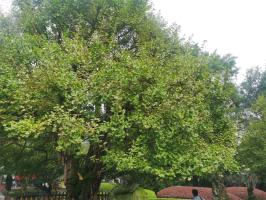Introduction
Climate change is a major concern facing the world today, and many people are looking for ways to reduce their impact on the environment. One popular solution is planting trees, which is often touted as an effective way to reduce carbon dioxide in the atmosphere. But does planting trees really reduce your carbon footprint, or is it just a feel-good solution without a significant impact?
The Role of Trees in the Carbon Cycle
To understand whether planting trees reduces your carbon footprint, it’s important to first understand the role of trees in the carbon cycle. Trees absorb carbon dioxide from the atmosphere during photosynthesis, storing the carbon in their leaves, branches, trunks, and roots. This means that planting trees can help to offset the carbon emissions produced by human activities, such as driving cars, flying in planes, or using electricity.
The Impact of Tree Planting on Carbon Footprint
While planting trees does have a positive impact on the environment, it’s important to understand the limitations of tree planting as a solution to climate change. First, it takes time for trees to grow and absorb significant amounts of carbon. A young tree might only absorb a few kilograms of carbon dioxide per year, while a mature tree could absorb hundreds of kilograms or even over a ton of carbon dioxide per year. This means that planting trees is more of a long-term solution than a quick fix.
Second, not all trees are equally effective at absorbing carbon. Fast-growing trees like eucalyptus might seem like a good choice, but they often have a low carbon sequestration rate compared to slow-growing trees like oak or pine. In addition, planting trees in areas where they are not native or replacing existing forests with new ones can actually disrupt the balance of ecosystems and lead to a net increase in carbon emissions.
The Importance of Tree Conservation
While planting trees is a worthwhile endeavor, it’s also important to focus on conserving and protecting existing forests. Forests play a critical role in the carbon cycle, absorbing a significant amount of carbon dioxide from the atmosphere and storing it in the soil, trees, and other organic matter. Deforestation not only removes this carbon sink but releases the carbon stored in the trees and soil, leading to a net increase in carbon dioxide emissions.
Conserving forests is also important for preserving biodiversity, preventing soil erosion, and providing habitats for wildlife. In many cases, protecting existing forests is a more effective and efficient way to mitigate climate change than planting new trees.
The Bottom Line
Planting trees can be a valuable way to reduce your carbon footprint and contribute to the fight against climate change. However, it’s important to recognize the limitations of tree planting and the importance of forest conservation. To have a meaningful impact on the environment, it’s necessary to take a holistic approach, reducing carbon emissions wherever possible, planting trees in appropriate locations, and protecting the vital ecosystems that already exist.

 how many times do yo...
how many times do yo... how many planted tre...
how many planted tre... how many pine trees ...
how many pine trees ... how many pecan trees...
how many pecan trees... how many plants comp...
how many plants comp... how many plants can ...
how many plants can ... how many plants and ...
how many plants and ... how many pepper plan...
how many pepper plan...






























